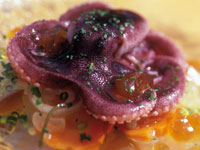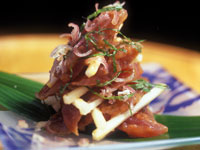Trevor Blyth on bringing together French and Japanese cuisine
The unprepossessing location of the White Fox - up a steep flight of steeps at the back entrance of a commuter railway station north of central Tokyo - belies the wonderful gastronomic treasures that can be found inside.
Dishes such as a succulent tuna shoulder terrine accompanied by a punchy raisin and caper sauce, daikon and horseradish flavoursome maitake mushrooms partnered with perfectly cooked asari clams and the lightest black rice pudding with pineapple, ginger and lime are just a taster of what is offered on the all-encompassing menu. Served with great charm and in the most understated fashion, the food is produced almost single-handedly by British chef Trevor Blyth, who combines his many years of classical training and experience in England and France with the flavours and techniques that he has grown to love during the past seven years he has spent in Japan. Blyth, 39, opened the White Fox just over a year ago with his Japanese wife, Hiromi, who runs the front-of-house service with great charisma. The place is tiny, basic and informal - think concrete walls and just 20 seats arranged along a counter top and around a few bare tables. Blyth's cooking facilities are equally minimal: just two ceramic electric cooking plates and an oven no larger than a domestic microwave. Virtually every dish is cooked to order by Blyth, assisted by his one full-time member of staff, Harue Yagi, who trained for one year at Le Cordon Bleu in London, where she also completed stages at Sketch, the Ritz and Claridge's. "Much of my cooking is done in the preparation," explains Blyth. "For me it is a better way to cook, as it is very controllable when it comes to purchasing, service and staff."
 |
| Whole poached iidako (baby octopus), konbu escabèche and ponzu jelly |
Following a spell working at two very British establishments - Rules in Covent Garden, London, and Waldo's at Cliveden in Berkshire - Blyth was reacquainted with Japanese cuisine when he went to work for Michel Guérard at his three-Michelin-starred restaurant, Les Prés d'Eugénie in Eugénie-les-Bains, in 1993. "I worked alongside stagières from all over the world, including five from Japan," says Blyth, who, when he returned to the UK the following year to work under Michel Roux Jnr at Le Gavroche in London, was joined by one of the young Japanese chefs whom he had got to know so well in France.
 |
| Sashimi of tuna, umeboshi (preserved plums), green apple, oba (mint-like leaves) and miyoga (a type of ginger) |
 |
| Duck tataki sushi, almond and ginger rice, tapenade and kumquat pickle. |
A small selection of otsumami dishes are also available, some European, some Japanese, and some a mixture of the two. The choice includes mozzarella, tomato and basil bruschetta (¥550/£2.40), cream cheese mousse, pickled daikon, negi (long Japanese onion) and pine nuts (¥650/£2.85), and grilled spiced scallop, white miso aïoli (aïoli made with white fermented soy bean paste) and sweet potato chips (¥850/£3.75). After 5.30pm the whole mood of the restaurant changes: the lights are lowered and a new menu offering a mix of simple one-ingredient dishes and some more complex dishes becomes available. There are a total of 25 savoury dishes, five cheeses and four desserts, as well as ice-creams and sorbets. In the evening most customers order four to six dishes, plus a cheese and dessert, each spending an average of ¥6,000 (£26.30). "Customers generally keep hold of the menu and order one dish after another to share. It is a very relaxed way of eating," says Blyth. The European influence is seen in simple plates of smoked duck, capers and balsamic vinegar (¥550/£2.40) or grilled Iberico chorizo (¥600/£2.65) or the more complex roulade of foie gras, Sauternes jelly and brioche toast (¥1,200/£5.25). Other dishes explore both the subtleties and complexities of Japanese cooking, such as the maitake mushrooms from Fukushima (¥850/£3.75) served with asari clams and pancetta, onsen tamago (slowly poached egg cooked at 60°C for 20 minutes), negi and kabosu (sharp-tasting green citrus fruit). A good example of the marriage of Japanese flavours and Western techniques is Blyth's dish of poached iidako (baby octopus) served with konbu escabèche and ponzu jelly (¥850/£3.75). The escabèche treatment of konbu, the seaweed rich in umami flavours (see panel, right), appeals to the Japanese because of their love of vinegary marinades. Thin strips of the konbu are presoaked in a sweet and salty rice vinegar before being marinated with carrots, onion, shallots, bannonegi, rice vinegar, sake, mirin, olive oil, coriander seeds, pink peppercorns and lemon juice. The ponzu jelly, made from the ponzu citrus fruit mixed with soy sauce and flakes of katso (skipjack tuna), is a well-matched accompaniment to the konbu, as both konbu and ponzu are essential components of dashi, the stock that forms the basis of much of Japanese cooking. The duck tataki sushi (tataki means that the duck is swiftly cooked on the outside and served pink in the middle) is served over a mound of almond and ginger rice combined with the European-influenced tapenade and savoury orange zest (¥1,200/£5.25). A more direct taste of Japan is present in the sashimi of tuna with umeboshi (plums preserved in salt and blended with soy sauce, sake, mirin and olive oil), green apple, oba (fresh green leaves) and miyoga (a type of ginger) (¥850/£3.75). Cooked to order
While most dishes are cooked to order, a dish of braised Okinawan royal pork (¥1,400/£6.15) is put together at the last minute after the meat has been slowly cooked, French-style, with the addition of the Japanese flavours of soy sauce, mirin and sake. This robustly flavoured pork is served with Puy lentils, cabbage, nira (green leaves with a delicate garlic flavour) and shungiku (chrysanthemum leaves). European cheese is enormously popular with the Japanese, although very expensive. "But they are happy to pay for it if it is good quality," says Blyth, who offers a choice of five European cheeses, including one British - Wensleydale - at ¥550 (£2.40) per portion or ¥1,800 (£7.90) for all five. Desserts (all costing ¥550/£2.40) once again highlight Blyth's love of mixing the two cultures, with choices including banana and black sesame bavarois with ume-shu (an alcoholic drink made from plums), granité and green tea parfait with white chocolate and griottine cherry fondant. The dark chocolate and walnut délice with spiced oranges is more of a direct replica of what Blyth may have made back home in England. The choice of beverages at the end of the meal includes the world's rarest and most expensive coffee, kopi luwak from Indonesia (¥1,400/£6.15). Only for the faint-hearted, kopi luwak is extracted from the droppings of the civet cat which feeds off crimson coffee berries in Sumatra. The excreted beans are thoroughly cleaned and prepared for drinking. Surprisingly, the flavour of the coffee is mellow, with little aftertaste. Blyth describes his cooking style today as one that has progressed naturally from his love of French cuisine to his increasing interest in Japanese cuisine in all its diversities. "Cooking for me is, first and foremost, a creative art, so on learning something new I have a natural desire to apply it to what I already know. What we do here is not mindless fusion, but the careful, thoughtful combination of two of the greatest and most versatile cuisines in the world, French and Japanese." Sushi winner
Trevor Blyth's creativity with Japanese flavours and techniques has recently been recognised beyond the Tokyo restaurant scene, with his version of a sushi dish scooping first prize - and return flight tickets between Tokyo and London - in the Original Sushi Competition 2007 organised by Eat-Japan, a website that provides advice on Japanese ingredients, cooking and restaurants. He triumphed over more than 450 entrants, many of whom were Japanese.Blyth's winning dish - peppered mahi mahi tataki on almond and ginger sushi rice served with salted yuzu (Japanese citrus fruit) and shiso (perilla leaves) compote and pickled fennel strip - has proved popular with both Japanese and Western customers at the White Fox.
"I wanted to use mahi mahi - found in the Pacific - to raise awareness of the fish. It is especially good for tataki and carpaccio-style dishes. If more chefs were aware of it, they could use it in place of bluefin tuna, which would help to ease the current burden on that species."
Japanese ingredients
Hugely inspired by the local ingredients, Trevor Blyth declares that Japanese fish and beef are the best in the world. With Tsukiji, the largest fish market in the world, situated in Tokyo, the choice and freshness of fish is breathtaking.
"There are so many different types of tuna, for instance, including four different types of yellowfin tuna," says Blyth.While Kobe is the most widely known Japanese beef, it is not necessarily the best, according to Blyth.
"Matuzaka beef, which comes from an area close to Kobe, is of a much finer quality, although it is more expensive.
"However, some fruit and vegetables grown in Japan are not as good as those from Europe, particularly varieties that require slow growth.
"For example, there is a problem with potatoes and tomatoes," says Blyth.
"The volcanic soil makes them grow too quickly before they've had a chance to develop any depth of flavour."
The sense of umami
The Japanese generally have the ability to detect subtleties of flavour that a Western palate would not recognise and are therefore aware of umami - the savoury fifth taste that exists alongside the better-known sweet, sour, salt and bitter.
Umami is basically glutamic acid. The length of cooking of an ingredient can alter the umami flavour, so the intensity of clams, for instance, can be lost if they are slightly overcooked.
"This is something that the Japanese understand very well," says Blyth. "It is a great skill to ensure ingredients are cooked to the exact point where the umami level is at its peak and before it loses the important intensity of flavour."










